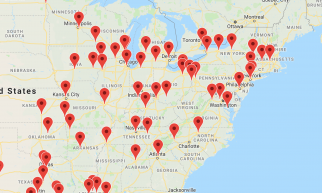A beetle may or may not be inferior to a man— the matter awaits demonstration; but if he were inferior by ten thousand fathoms, the fact remains that there is probably a beetle view of things of which a man is entirely ignorant. If he wishes to conceive that point of view, he will scarcely reach it by persistently revelling in the fact that he is not a beetle. (“A Defence of Humilities,” The Defendant)
THE EMERALD ASH BORER (EAB) came through our region about ten years ago. First came the dire predictions that it was coming; it had been seen in central US. Then the warnings to look for it and lastly stories of how it had finally come across the border into Ontario. A small industry grew up around this beautiful emerald green beetle. It provided employment for sign painters, apocalyptic news stories, and lots of work for the tree pruning industry, both public and private.
Our town, like most towns where the EAB had been seen, responded by cutting down ash trees.
Whole streets were denuded of shade lest the EAB got into the ash trees beforehand.
The problem with the EAB is that it can kill ash trees with a 98% to 99% mortality rate, which means that 99 out of 100 ash trees die if attacked by the EAB. This also means that 1 in 100 can survive the EAB. However, no ash trees can survive chainsaw attacks, even if cutting them down is done with good intentions.
The EAB is from China, where it only attacks sick ash trees. The ash trees in China have thick bark which makes healthy trees immune to the EAB. Most of our North American ash trees do not have thick enough bark.
But some do. However, none have bark thick enough to be immune to chainsaws. It is really very simple. If you cut down the immune trees, these cannot spread their seeds making new immune ash trees in the forest.
When the EAB first arrived from China, it had a huge advantage – woodpeckers and other birds did not know it could be eaten or even where to find them. But woodpeckers learn fast, and they now know where and how to find EAB and are doing great work hunting them down. It is not just woodpeckers; parasitic wasps, flies, and other insects, as well as various viral and fungal diseases are all now attacking EAB. This is why the doomsday predictions (as always!) did not come true.
Many of us in the insect pest management field knew this was going to happen, because this is what always happens. We vocally opposed the end-of-the-world-for-ash-tree scenarios as an overreaction based on flawed assumptions.
The locust borer was going to kill all black locust trees in the early 1900’s. Dutch Elm disease was going to kill all elm trees in the 1950’s. The spongy moths (what used to be called gypsy moths) were going to kill all the trees over the past 100 years. None of these predictions have come true because they were all based on drawing graphs, connecting the dots, then extending this line through the top of the page.
This is not how living things work in the real world.
In the real world, woodpeckers might not know how to read graphs, but they do know how to eat bugs hiding under the bark once they get a taste for them, as do starlings, chickadees, other birds, mice, rats, squirrels, and various insect predators.
Last year I was interviewed on the radio and some local papers as an insect pest expert, on a recent outbreak of spongy moths that stripped the leaves from trees in local parks for two years in a row. I explained that this happens every one or two decades. Outbreaks last about two years after they first are noticed. Each year, as there are more caterpillars, some get a viral disease that turns the caterpillar into dust. When the wind blows this infectious dust, it spreads out from the dead caterpillars to infest its neighbors. This, and the birds that eat them, kill off the population for another ten to twenty years.
From this publicity, I was asked to speak to a local officials of The City of Kawartha Lakes. I tried to explain these dynamics at the Council meeting. I then explained that if someone tries to spray pesticides, this kills just enough caterpillars to delay the whole wind-borne poison dust process by a year or more, causing the outbreak to last longer.
I was told I was wrong: “Everyone know that spraying pesticides kills insects.”
I explained that killing insects with poison in a jar is the not the same as killing insects by dropping poison from airplanes. In a jar they cannot get away, on real trees caterpillars hide under the leaves.
The mayor then informed me that they were going to spend millions on spraying from the air and what did I think of that. I said that the pilot’s kids would get nice Christmas presents that year, and they would have more dead trees as they extended the outbreak for another year or more.
They voted. The motion to spray was rejected by council.
I have not been invited back.
David Beresford is a biology professor at OLSWC, an entomologist, and lives on a farm in Douro-Dummer, Ontario.






